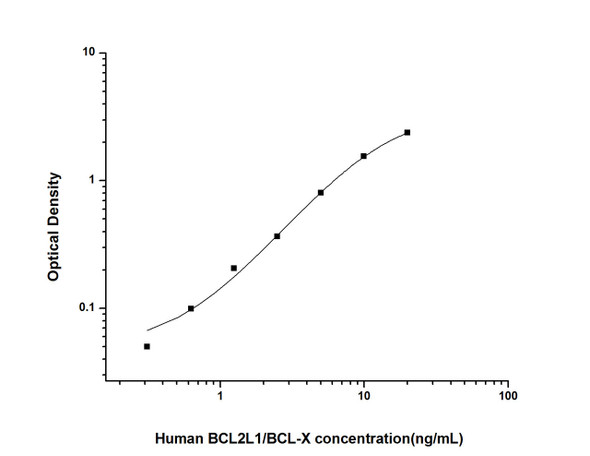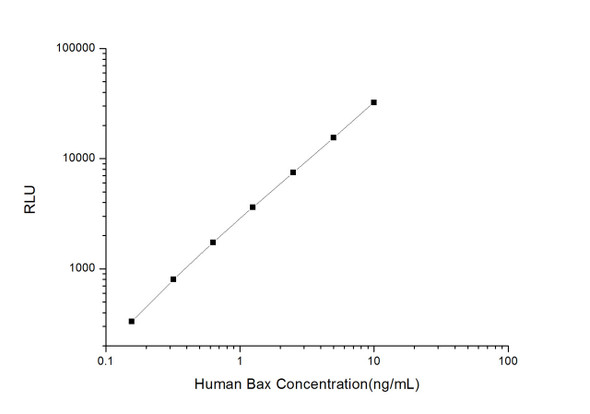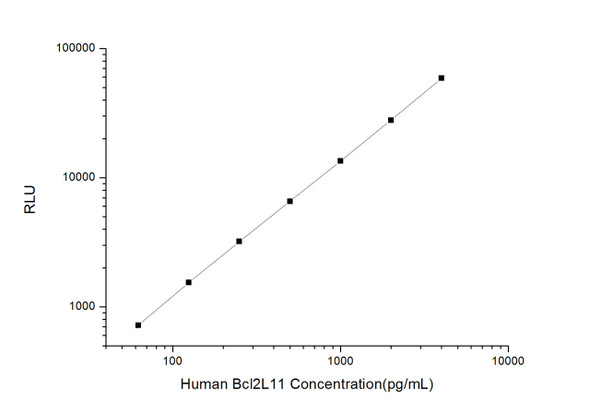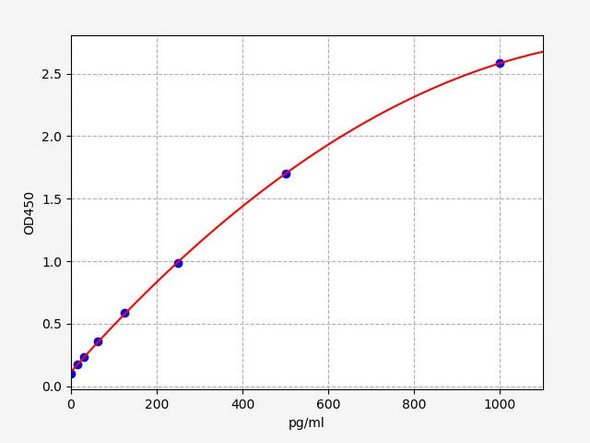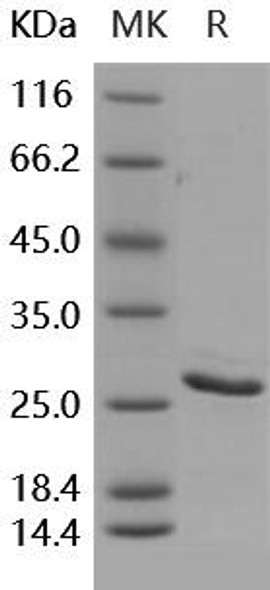Human Cell Death ELISA Kits
Human BCL2L1/BCL-X (Bcl-2 Like Protein 1/Bcl2 Associated X Protein) CLIA Kit (HUES00378)
- SKU:
- HUES00378
- Product Type:
- ELISA Kit
- ELISA Type:
- CLIA Kit
- Size:
- 96 Assays
- Sensitivity:
- 37.5pg/mL
- Range:
- 62.5-4000pg/mL
- ELISA Type:
- Sandwich
- Reactivity:
- Human
- Sample Type:
- Serum, plasma and other biological fluids
- Research Area:
- Cell Death
Description
| Assay type: | Sandwich |
| Format: | 96T |
| Assay time: | 4.5h |
| Reactivity: | Human |
| Detection method: | Chemiluminescence |
| Detection range: | 62.50-4000 pg/mL |
| Sensitivity: | 37.50 pg/mL |
| Sample volume: | 100µL |
| Sample type: | Serum, plasma and other biological fluids |
| Repeatability: | CV < 15% |
| Specificity: | This kit recognizes Human BCL2L1/BCL-X in samples. No significant cross-reactivity or interference between Human BCL2L1/BCL-X and analogues was observed. |
This kit uses Sandwich-CLIA as the method. The micro CLIA plate provided in this kit has been pre-coated with an antibody specific to Human BCL2L1/BCL-X. Standards or samples are added to the appropriate micro CLIA plate wells and combined with the specific antibody. Then a biotinylated detection antibody specific for Human BCL2L1/BCL-X and Avidin-Horseradish Peroxidase (HRP) conjugate are added to each micro plate well successively and incubated. Free components are washed away. The substrate solution is added to each well. Only those wells that contain Human BCL2L1/BCL-X, biotinylated detection antibody and Avidin-HRP conjugate will appear fluorescence. The Relative light unit (RLU) value is measured spectrophotometrically by the Chemiluminescence immunoassay analyzer. The RLU value is positively associated with the concentration of Human BCL2L1/BCL-X. The concentration of Human BCL2L1/BCL-X in the samples can be calculated by comparing the RLU of the samples to the standard curve.
| UniProt Protein Function: | Bcl-xL: an antiapoptotic member of the Bcl-2 family. Located at the outer mitochondrial membrane and regulates outer mitochondrial membrane channel (VDAC) opening. VDAC regulates mitochondrial membrane potential, and thus controls the production of reactive oxygen species and release of cytochrome C by mitochondria, both of which are potent inducers of cell apoptosis. Two alternatively spliced isoforms have been reported. |
| UniProt Protein Details: | Protein type:Mitochondrial; Autophagy; Apoptosis; Membrane protein, integral Chromosomal Location of Human Ortholog: 20q11. 21 Cellular Component: cell junction; centrosome; cytoplasm; cytosol; integral to membrane; mitochondrial inner membrane; mitochondrial matrix; mitochondrial outer membrane; mitochondrion; nuclear membrane; synaptic vesicle membrane Molecular Function:BH3 domain binding; identical protein binding; protein binding; protein heterodimerization activity; protein homodimerization activity; protein kinase binding Biological Process: apoptotic mitochondrial changes; cell proliferation; cellular process regulating host cell cycle in response to virus; cytokinesis; DNA damage response, signal transduction resulting in induction of apoptosis; endocytosis; fertilization; germ cell development; growth; in utero embryonic development; male gonad development; mitotic cell cycle checkpoint; negative regulation of apoptosis; negative regulation of autophagy; negative regulation of neuron apoptosis; neuron apoptosis; ovarian follicle development; positive regulation of cell proliferation; regulation of mitochondrial membrane permeability; regulation of mitochondrial membrane potential; release of cytochrome c from mitochondria; response to cycloheximide; response to cytokine stimulus; spermatogenesis; suppression by virus of host apoptosis |
| NCBI Summary: | The protein encoded by this gene belongs to the BCL-2 protein family. BCL-2 family members form hetero- or homodimers and act as anti- or pro-apoptotic regulators that are involved in a wide variety of cellular activities. The proteins encoded by this gene are located at the outer mitochondrial membrane, and have been shown to regulate outer mitochondrial membrane channel (VDAC) opening. VDAC regulates mitochondrial membrane potential, and thus controls the production of reactive oxygen species and release of cytochrome C by mitochondria, both of which are the potent inducers of cell apoptosis. Alternative splicing results in multiple transcript variants encoding two different isoforms. The longer isoform acts as an apoptotic inhibitor and the shorter isoform acts as an apoptotic activator. [provided by RefSeq, Dec 2015] |
| UniProt Code: | Q07817 |
| NCBI GenInfo Identifier: | 728955 |
| NCBI Gene ID: | 598 |
| NCBI Accession: | Q07817. 1 |
| UniProt Secondary Accession: | Q07817,Q5CZ89, Q5TE65, Q92976, E1P5L6, |
| UniProt Related Accession: | Q07817 |
| Molecular Weight: | 25,290 Da |
| NCBI Full Name: | Bcl-2-like protein 1 |
| NCBI Synonym Full Names: | BCL2 like 1 |
| NCBI Official Symbol: | BCL2L1 |
| NCBI Official Synonym Symbols: | BCLX; BCL2L; Bcl-X; PPP1R52; BCL-XL/S |
| NCBI Protein Information: | bcl-2-like protein 1 |
| UniProt Protein Name: | Bcl-2-like protein 1 |
| UniProt Synonym Protein Names: | Apoptosis regulator Bcl-X |
| UniProt Gene Name: | BCL2L1 |
| UniProt Entry Name: | B2CL1_HUMAN |
As the RLU values of the standard curve may vary according to the conditions of the actual assay performance (e. g. operator, pipetting technique, washing technique or temperature effects), the operator should establish a standard curve for each test. Typical standard curve and data is provided below for reference only.
| Concentration (pg/mL) | RLU | Average | Corrected |
| 4000 | 58157 60005 | 59081 | 59046 |
| 2000 | 25635 30083 | 27859 | 27824 |
| 1000 | 13771 13197 | 13484 | 13449 |
| 500 | 6404 6806 | 6605 | 6570 |
| 250 | 3467 3019 | 3243 | 3208 |
| 125 | 1698 1464 | 1581 | 1546 |
| 62.50 | 732 778 | 755 | 720 |
| 0 | 34 36 | 35 | -- |
Precision
Intra-assay Precision (Precision within an assay): 3 samples with low, mid range and high level Human BCL2L1/BCL-X were tested 20 times on one plate, respectively.
Inter-assay Precision (Precision between assays): 3 samples with low, mid range and high level Human BCL2L1/BCL-X were tested on 3 different plates, 20 replicates in each plate.
| Intra-assay Precision | Inter-assay Precision | |||||
| Sample | 1 | 2 | 3 | 1 | 2 | 3 |
| n | 20 | 20 | 20 | 20 | 20 | 20 |
| Mean (pg/mL) | 205.44 | 392.40 | 1521.80 | 200.97 | 380.04 | 1385.58 |
| Standard deviation | 22.21 | 27.62 | 151.42 | 25.22 | 35.69 | 85.77 |
| C V (%) | 10.81 | 7.04 | 9.95 | 12.55 | 9.39 | 6.19 |
Recovery
The recovery of Human BCL2L1/BCL-X spiked at three different levels in samples throughout the range of the assay was evaluated in various matrices.
| Sample Type | Range (%) | Average Recovery (%) |
| Serum (n=5) | 90-103 | 95 |
| EDTA plasma (n=5) | 88-102 | 93 |
| Cell culture media (n=5) | 93-103 | 98 |
Linearity
Samples were spiked with high concentrations of Human BCL2L1/BCL-X and diluted with Reference Standard & Sample Diluent to produce samples with values within the range of the assay.
| Serum (n=5) | EDTA plasma (n=5) | Cell culture media (n=5) | ||
| 1:2 | Range (%) | 93-109 | 98-116 | 94-106 |
| Average (%) | 101 | 106 | 99 | |
| 1:4 | Range (%) | 99-111 | 102-117 | 86-98 |
| Average (%) | 105 | 107 | 91 | |
| 1:8 | Range (%) | 96-108 | 88-100 | 85-99 |
| Average (%) | 103 | 93 | 92 | |
| 1:16 | Range (%) | 89-105 | 93-109 | 98-113 |
| Average (%) | 96 | 99 | 106 |
An unopened kit can be stored at 4°C for 1 month. If the kit is not used within 1 month, store the items separately according to the following conditions once the kit is received.
| Item | Specifications | Storage |
| Micro CLIA Plate(Dismountable) | 8 wells ×12 strips | -20°C, 6 months |
| Reference Standard | 2 vials | |
| Concentrated Biotinylated Detection Ab (100×) | 1 vial, 120 µL | |
| Concentrated HRP Conjugate (100×) | 1 vial, 120 µL | -20°C(shading light), 6 months |
| Reference Standard & Sample Diluent | 1 vial, 20 mL | 4°C, 6 months |
| Biotinylated Detection Ab Diluent | 1 vial, 14 mL | |
| HRP Conjugate Diluent | 1 vial, 14 mL | |
| Concentrated Wash Buffer (25×) | 1 vial, 30 mL | |
| Substrate Reagent A | 1 vial, 5 mL | 4°C (shading light) |
| Substrate Reagent B | 1 vial, 5 mL | 4°C (shading light) |
| Plate Sealer | 5 pieces | |
| Product Description | 1 copy | |
| Certificate of Analysis | 1 copy |
- Set standard, test sample and control (zero) wells on the pre-coated plate and record theirpositions. It is recommended to measure each standard and sample in duplicate. Note: addall solutions to the bottom of the plate wells while avoiding contact with the well walls. Ensuresolutions do not foam when adding to the wells.
- Aliquot 100µl of standard solutions into the standard wells.
- Add 100µl of Sample / Standard dilution buffer into the control (zero) well.
- Add 100µl of properly diluted sample (serum, plasma, tissue homogenates and otherbiological fluids. ) into test sample wells.
- Cover the plate with the sealer provided in the kit and incubate for 90 min at 37°C.
- Aspirate the liquid from each well, do not wash. Immediately add 100µL of BiotinylatedDetection Ab working solution to each well. Cover the plate with a plate seal and gently mix. Incubate for 1 hour at 37°C.
- Aspirate or decant the solution from the plate and add 350µL of wash buffer to each welland incubate for 1-2 minutes at room temperature. Aspirate the solution from each well andclap the plate on absorbent filter paper to dry. Repeat this process 3 times. Note: a microplatewasher can be used in this step and other wash steps.
- Add 100µL of HRP Conjugate working solution to each well. Cover with a plate seal andincubate for 30 min at 37°C.
- Aspirate or decant the solution from each well. Repeat the wash process for five times asconducted in step 7.
- Add 100µL of Substrate mixture solution to each well. Cover with a new plate seal andincubate for no more than 5 min at 37°C. Protect the plate from light.
- Determine the RLU value of each well immediately.


